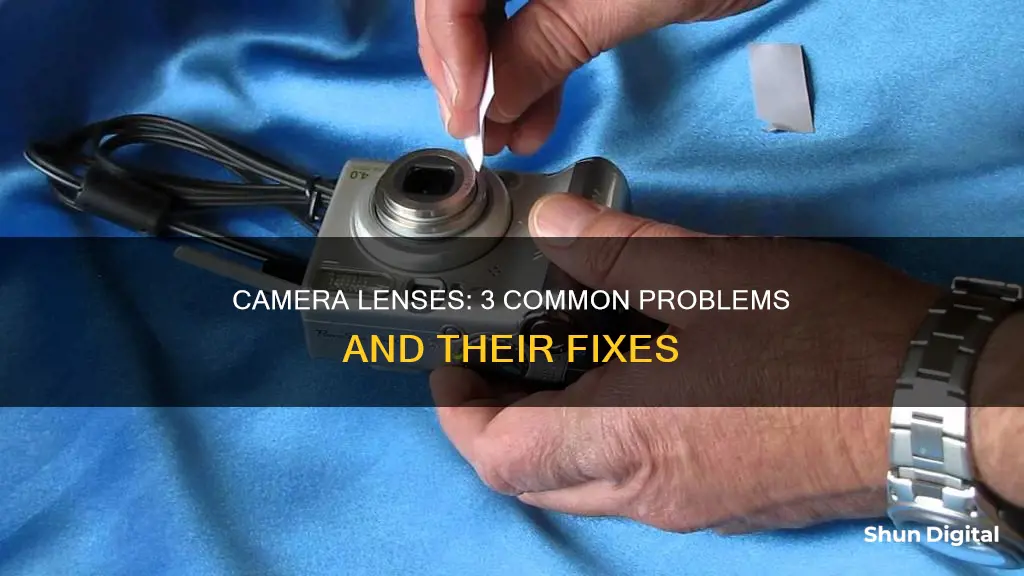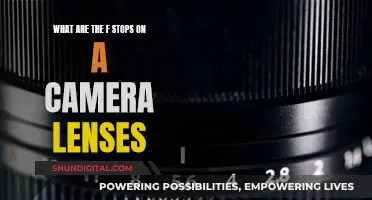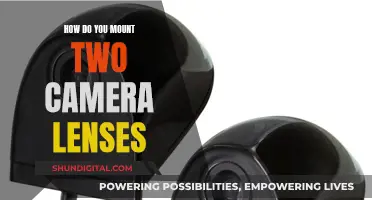
Camera lenses are an essential component of photography, but they can also present challenges for photographers, from beginners to professionals. While lenses offer creative opportunities, such as playing with focus and perspective, they also come with their own set of issues. One of the most common problems is lens flare, which occurs when unwanted light enters the lens and creates artefacts in photos. This can be mitigated by using a lens hood to block stray light. Another issue is blurry images, which could be due to dust and dirt accumulation on the lens or problems with the autofocus system. Cleaning the lens and ensuring proper autofocus settings are crucial steps to address this problem. Additionally, image stabilisation plays a vital role in avoiding shaky photos, especially in low-light conditions. Photographers should also be cautious about aperture problems, as they can affect exposure and depth of field. Regular maintenance and cleaning of lenses are essential to prevent these issues.
What You'll Learn

Flare and artefacts in photos
Understanding Flare and Artefacts
Flare occurs when unwanted light enters the camera lens and scatters inside the lens body. This results in artefacts, which are unusual colours, circles, rings, or haze that appear in the photograph. Artefacts can reduce the contrast and sharpness of an image, creating a soft or washed-out look. They can also introduce hotspots and affect the autofocus system.
Causes of Flare and Artefacts
The main cause of flare and artefacts is shooting directly into a bright light source, such as the sun or strong artificial lights. Wide-angle lenses are particularly susceptible due to their wide field of view, which increases the likelihood of capturing a light source in the frame. Additionally, lenses with more optical elements are more prone to flare due to unwanted reflections between the layers of glass. Imperfections, dust, or dirt on the lens surface can also contribute to this issue.
Preventing and Reducing Flare and Artefacts
To prevent flare and artefacts, it is recommended to use a lens hood, which blocks stray light from entering the lens. Shooting from a different angle or using an obstacle, such as leaves or your hand, to block the light source can also help. Keeping your lens clean and free of dust, fingerprints, and other debris is essential. Using a lens cleaning kit and a lens cloth regularly can help minimise these issues.
Artistic Use of Flare and Artefacts
While flare and artefacts are often considered undesirable, they can also be used artistically to add mood, atmosphere, or a dreamy effect to your photographs. If you wish to incorporate flare intentionally, try shooting directly at lights during the golden hour (the hour after sunrise or before sunset) to capture a golden glow in your images.
Post-Processing Solutions
If you want to remove flare and artefacts during post-processing, you can use image-editing software. Adobe Camera Raw, Lightroom, and Photoshop offer tools like the Defringe tool to remove chromatic aberration and other artefacts effectively. Additionally, you can use techniques like bracketing and the "hand or finger method" to capture multiple exposures and then blend them to reduce the impact of flare and artefacts in your final image.
Cleaning Camera Lenses: Mars Exploration Tips
You may want to see also

Focusing problems
Check Your Autofocus Settings
Start by checking if your autofocus settings are accurate. Sometimes, the issue might be as simple as forgetting to switch back to autofocus from manual focus. Most lenses have a small switch that allows you to toggle between the two, but it's easy to overlook. Some Nikon cameras have an "AF/MF" switch on both the lens and the camera body, so be sure to check both.
Minimum Focusing Distance
Another factor to consider is your proximity to the subject. All lenses have a specific "minimum focusing distance," and being too close to your subject can result in blurry images. If you're having trouble focusing, try taking a couple of steps back and refocusing.
Viewfinder Diopter
If you're having difficulty seeing clearly through your viewfinder, the issue might lie with the diopter. Fine-tune the dial until you achieve a clear image in your viewfinder. Adjusting the viewfinder diopter can be particularly helpful if you have eyesight problems, such as nearsightedness or farsightedness.
Lighting Conditions
Low-light conditions can also impact your camera's ability to focus. In such situations, selecting the center focus point is recommended, as it is the most accurate and strongest option among the cross-type AF points. Additionally, utilizing a focus assist light can aid your camera in low-light situations by helping it gauge where to focus.
High-Contrast Areas
Whether you're shooting in low light or not, look for areas of high contrast in the frame. Cameras can more easily track focus in areas with higher contrast. Avoid using Servo modes in low light, as they tend to be inaccurate and unreliable due to the lack of high-contrast areas. Instead, manually find your point of focus.
Flares
Flares can add an artistic element to your photos, but they also provide challenges for your camera's autofocus system. Flares reduce contrast, and your camera struggles to focus between the darkest and brightest points of the image. Try using your hand or a lens hood to block out the light, and then lock your focus. You may also need to change your position relative to the subject and the source of the flare.
Focus Lock
When possible, locking your focus can help ensure accurate results, especially in still situations. If you know exactly where the focus will be and your subject remains stationary, locking your focus reduces the risk of missing the mark with autofocus. You can manually toggle the focus options or designate a button to trigger the 'autofocus lock' feature.
Pre-Focusing with the Shutter Button
Some cameras allow you to pre-focus by holding the shutter button halfway down to lock the focus and then taking the shot. This feature is available on some Sony cameras and is becoming more common in other models.
Subject Placement
Switching to manual focus is recommended when your subjects are on a similar plane, especially when shooting at a shallow depth of field. This helps maintain accuracy, as autofocus may struggle to decide which area to focus on in such scenarios.
Live View with Manual Focus
Using live view in conjunction with manual focusing can also improve accuracy. Zooming in on your subjects allows you to lock in on the critical focus point.
Touch Screen Focus Points
If you have a newer camera model, you may have the option to use touch screen focusing when using live view. This feature provides an intuitive way to select the desired point of focus, similar to how we lock focus on our mobile devices.
Best Places to Sell Your Camera Lenses Online
You may want to see also

Image stabilisation and shakiness
Image stabilisation is a feature that helps photographers take clear pictures in low-light conditions and when using long focal length lenses. It works by reducing the blurring associated with the motion of a camera during exposure. This technology is particularly useful when shooting handheld, as it minimises the shakiness that occurs when the camera is held by hand.
There are two types of image stabilisation: lens-based and in-camera. Lens-based stabilisation uses a floating lens element that is controlled electronically and shifted in the opposite direction to any camera shake that is detected. This type of stabilisation is usually found in longer lenses and can be quite costly. It also adds weight and complexity to the lens.
In-camera image stabilisation, on the other hand, works by shifting the image sensor to compensate for camera movement. This type of stabilisation is typically found in mirrorless cameras and has the advantage of working with any lens that can be mounted on the camera. It is also less expensive than lens-based stabilisation.
While image stabilisation can be a helpful feature, it is not always necessary. If you are shooting in good lighting conditions or using a tripod, you may not need image stabilisation. Additionally, if you are shooting video on a tripod, it is recommended to turn off image stabilisation as it can cause subtle movements in the video that make it appear worse. Similarly, if you are using a lens-based stabilisation system on a tripod, it is recommended to turn it off to avoid creating a feedback loop where the camera's stabilisation system detects its own vibrations and starts moving around, causing blurriness in the image.
To summarise, image stabilisation can be a useful feature for photographers who often shoot handheld in low-light conditions or with long focal length lenses. It helps reduce blur and shakiness in images. However, it is not always necessary, and there are times when it is better to turn it off, such as when using a tripod or shooting video.
Testing Camera Lenses: The Ultimate Sharpness Guide
You may want to see also

Aperture and exposure issues
Clean the Aperture Blades
It is important to regularly clean the aperture blades to ensure there is no dust or dirt buildup, as this can impact the amount of light entering the camera and affect your exposure.
Check Your Camera Settings
Ensure that your camera settings are correctly configured for the desired aperture. This includes settings such as shutter speed, ISO speed, and aperture priority mode. Mastering the use of these settings is essential for developing an intuition for photography and achieving the correct exposure.
Understand the Exposure Triangle
The exposure of a photograph is determined by the interplay of three camera settings: aperture, ISO, and shutter speed. Each of these settings controls exposure differently and can be adjusted to achieve the desired result. For example, a faster shutter speed means a shorter exposure time, while a larger aperture allows more light to enter the camera.
Avoid Diffraction
Diffraction is an optical effect that occurs at small aperture settings and can reduce the sharpness of your images. It is generally recommended to avoid the smallest aperture settings and instead use mid-range apertures, such as f/8, to maintain good detail levels.
Use a Lens Hood
A lens hood can help reduce lens flare, which occurs when unwanted light enters the lens and creates artefacts in your photos. By blocking stray light, a lens hood can improve your exposure and overall image quality.
Adjust Exposure Compensation
In some cases, your camera may struggle to expose white or light subjects correctly, resulting in grey or underexposed images. To fix this, manually adjust the exposure compensation to set your exposure above the value suggested by the camera.
Lock Your Exposure Settings
Accidentally knocking the mode dial or aperture/shutter speed dials can result in incorrect exposures. To prevent this, modern DSLRs allow you to lock your exposure settings once you have set them. Look for the function labelled AE-L (Auto Exposure Lock) to lock in your settings.
Understand Spot Metering
Spot metering allows you to meter for the central 5% of your image, but it can lead to incorrect exposures if left on accidentally. For example, if you are shooting a landscape and the spot metering falls on a darker part of the image, your image will be overexposed. Remember to adjust your metering mode based on the scene you are capturing.
Use a Graduated Neutral Density (ND) Filter
When shooting landscapes, the sky is often much brighter than the land, resulting in underexposed foregrounds. To correct this, use a graduated ND filter, which will help balance the exposure between the sky and the land.
Monitor Your Shutter Speed
When hand-holding your camera, it is important to ensure a fast enough shutter speed to avoid camera shake. If you are not getting a fast enough shutter speed, consider increasing your ISO to achieve sharper shots.
Adjust Your Metering Mode for Backlit Subjects
When lighting a subject from behind, your camera may struggle to expose the subject correctly. To correct this, change your metering mode to centre-weighted or use spot metering linked to your active AF point to expose correctly for off-centre subjects.
Correct Underexposed Shadows and Overexposed Highlights
When photographing high-contrast scenes, your camera may struggle to capture the full dynamic range, resulting in blown-out highlights or clipped shadows. To correct this, take multiple exposures for the highlights, mid-tones, and shadows, and combine them to create a single image with a full dynamic range.
Rely on the Viewfinder Instead of the LCD Screen
LCD screens can be inaccurate, as they are typically set to be brighter than the actual exposure of your image. To ensure correct exposure, rely on your camera's viewfinder and exposure indicator line, which will give you a more accurate representation of the image's exposure.
Claiming Camera Equipment on Taxes: A Comprehensive Guide
You may want to see also

Fungus and damage from humidity
Humidity and temperature changes can cause significant issues for camera lenses, including condensation and fungus growth. Condensation occurs when a camera moves from a cold environment to a warmer, humid one, or vice versa. In these situations, water vapour in the air condenses into liquid on the camera lens, causing blurry photos. To avoid this, photographers should be mindful of the dew point temperature and keep their equipment above this temperature. In hot, humid climates, this may involve storing equipment in air-conditioned spaces or sealed bags with moisture-absorbing silica gel.
Condensation can also lead to more serious issues, such as fungus growth inside the lens. This often occurs after prolonged exposure to humidity, and fungus is difficult and costly to remove, requiring the lens to be disassembled. To prevent this, photographers should ensure their equipment is properly sealed and dried after use in humid environments.
Black Friday Camera Lens Deals: What to Expect
You may want to see also







